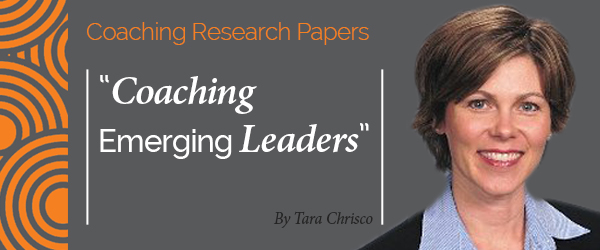Research Paper By Tara Chrisco
(Business & Leadership Coaching UNITED STATES)
According to a recent article in Talent Management Magazine, in the future, leaders will find themselves managing fewer standardized assumptions and practices that can be benchmarked, as more emergent and fluid models force them to constantly adapt. Tomorrow’s organizations may bear little resemblance to those we are familiar with, as demographic shifts, globalization and technology replace traditional work practices. (Rasmus, 2011) There are several factors that will shape tomorrow’s workplace. These factors include: major demographic shift, rapid change, and virtualization. Organizations that use coaching as a strategy to accelerate the growth and development of emerging leaders around these critical future considerations will have the competitive advantage they need to survive and thrive in this high demand, rapidly changing, “need for speed” world.
Identifying Emerging Leaders
When we look at identifying emerging leaders, we need to consider multiple levels. The five leadership levels are: individual contributors, first-‐line leaders, leaders of leaders, senior leaders and enterprise leaders. Specific behaviors and themes are consistently emphasized to varying degrees at the different levels. (Nikravan, 2012)
Identifying emerging leaders at every level is important when it comes to retaining top talent. There is no one-‐size-‐fits all definition for emerging leaders also commonly referred to as “high potentials.” Each organization must create their own definition in accordance with what they value and what is needed.
In order to do this effectively in today’s organization, we must simplify how we identify high potentials. Elaborate competency models don’t often predict which managers succeed. Sometimes they fail because the models are lists of good managerial and leadership behaviors, not the few vital behaviors that differentiate success. Often they quickly become outdated as the organization’s strategy changes.
By the time you’ve developed and implemented a certain type of model, it’s only likely to be accurate for a few years at best. (Effron, 2011)
A recent study concluded the following competencies and behaviors would be important for the 2020 Leader (Willyerd, 2010):
1. Collaborative Mind‐set
a. Inclusive decision making
b. Genuine solicitation of feedback
2. Developer of People
a. Mentors and coaches team
b. Provides straight feedback
3. Digitally Confident
a. Uses technology to connect to customers and employees
4. Global Citizen
a. Has a diverse mind-‐set
b. Prioritizes social responsibility
5. Anticipates and Builds for the Future
a. Builds accountability across levels
b. Champions innovation
This list clear and concise and leaves no room for misunderstanding. No more can we spend a year developing a competency model and laminate it for all to hang in their offices from that day on. Competency models need to be custom, flexible and adaptable at every level of leadership and as the demands of the business change. We need to re‐assess validity on an ongoing basis.
One effective retention strategy is to support the emerging leader’s efforts to improve themselves. This can be more valuable to employee than higher compensation offered by other companies because it keeps their skills competitive. It also shows employees the organization is willing to invest in them, which can influence their loyalty. There are two ways to support employee development:
coaching and development planning. (Garr, 2011) While the traditional manager has a broad range of responsibilities, a coach brings a laser focus to employee development. Without operational or administrative responsibility, the coach brings consistency to the emerging leader’s development which when coupled with ongoing feedback from management can accelerate the leader’s learning curve exponentially.
Coaching provides the ultimate flexibility when it comes to addressing the diverse development needs of these various levels of leadership. When a leader works one-‐ on-‐one with a coach, coaching and development plans unlike the traditional leadership development training programs, are customized to the individual in a way that addresses specific behavioral and skill gaps allowing the targeted, efficient focus on what needs to change first and how. Measurements are also tailored to provide the most effective feedback to the coaching client which gives then opportunity for “in-‐flight course correction” as needed instead of needing to wait for some corporate cycle of feedback to occur.
Bersin & Associates recently studied the impact of preparing for coaching interactions, engaging in strong coaching behaviors and providing concrete useful feedback. Results indicated a strong correlation between these coaching activities’ effectiveness and employee engagement. (Garr, 2011)
A Major Demographic Shift
The make‐up of the current workforce is undergoing a major shift. It is interesting to note the landscape of leadership is changing significantly on a daily basis and by the year 2020, will look notably different than the leadership profile of the recent past. We must prepare to onboard emerging leaders of the future differently than we have before.
